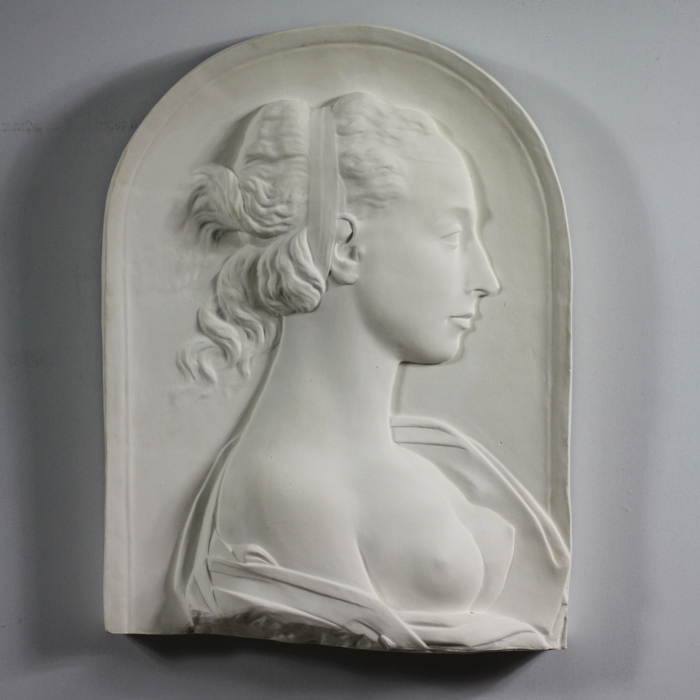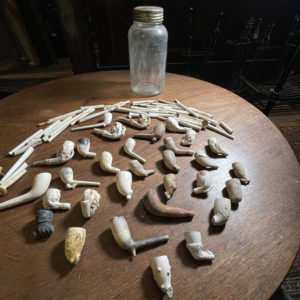A plaster portrait relief of “Lucretia”
the portrait of the woman in profile, cast in low relief,
£290
In stock (can be backordered)
Domenico Brucciani (1815-1880) was born in Lucca (now in Italy), moved to London as a young man, and by at least 1837, with a Gallery of Casts in Covent Garden, became a revered formatore – plaster-caster. His business built up special links with both the British Museum and the South Kensington Museum (later named The V&A).
His most substantial commission for the South Kensington Museum was the casting of the Pórtico de la Gloria, the 12th-century façade of the cathedral at Santiago de Compostela, in 1866. This huge undertaking – and many others including, famously, Trajan’s column itself – followed the agreement forged by Henry Cole and Prince Albert at the Paris Exposition of the previous year, signed by all the Crowned Princes of Europe, to further the common man’s experience of sculpture in-the-round by the reciprocal casting of great European sculpture. What followed was the Cast Courts at prestigious museums across Europe and beyond; Brucciani was foremost among the formatore.
He taught sculpture, moulding and casting at the Royal College of Art (including National Art Training School) from 1853 to 1861.
His company, D Brucciani & Co, with workshops in Clerkenwell, survived its founder with the Covent Garden outlet still operating into Edwardian times. A catalogue of their wares is held at The National Art library. However, by the turn of the century, the direct casting of priceless sculpture was being frowned upon – travel across Europe was now much easier anyway – the common man could now use the train. The company faltered. In the 1920’s its casting workshops were subsumed by the Victoria & Albert Museum.
LASSCO is delighted to have saved a number of the original piece-moulds and to have cast from them for the first time in a century. The making of piece-moulds – a plaster negative jigsaw enabling a cast to be released by the careful removal of the solid mould in pieces – is a lost art and today rendered redundant by pliant silicons. We have duly made a silicon mould in order to preserve Brucciani’s work. The accuracy and detail of the resulting casts, taken as they are directly from Settignano’s original carving is plain to see, and a delight.
Desiderio da Settignano was a master of portraiture and particularly in low-relief – this an excerpt from Wikipedia: ”
“Beyond the Marsuppini tomb and the San Lorenzo tabernacle, little of Desiderio’s work is documented or dated and a chronological reconstruction of his artistic development is a matter of conjecture based upon stylistic comparisons….
Desiderio made great contributions in the field of portraiture especially as it came to the representation of children. This was a genre which he practically reinvented, drawing upon Roman examples of the Augustan Age. Such sculptures present their youthful subjects with informality even animation; often with open-mouthed expression, they convey a sense of immediacy. His name has been connected with several marble and wooden female busts. The best of these includes the marble bust of Marietta Strozzi in Berlin that projects a soft, ethereal beauty that seems to originate from a marble surface that glows from within the stone.
Throughout his brief career, one of the most telling characteristics of his technique was his unusual ability to give to his sculptures a textural sensuousness that demands touch. Of all Quattrocento sculptors, Desiderio was, perhaps, the most tactile in his appeal. His work displays true understanding for the crystalline luminosity of marble and how a gently polished and modulated surface could produce an inner glow and how Donatello’s famed rilievo schiacciato could be further refined to convey a sense of light softly diffused by its passage through atmosphere. At his best Desiderio da Settignano was a sculptor of soft persuasion and subtle nuances.”
Lucretia – the subject of the plaque, is a figure associated with piety, chastity and having died around 508BC is remembered as the catalyst behind Rome abandoning its monarchy and becoming a Republic. Her full story is found here.


